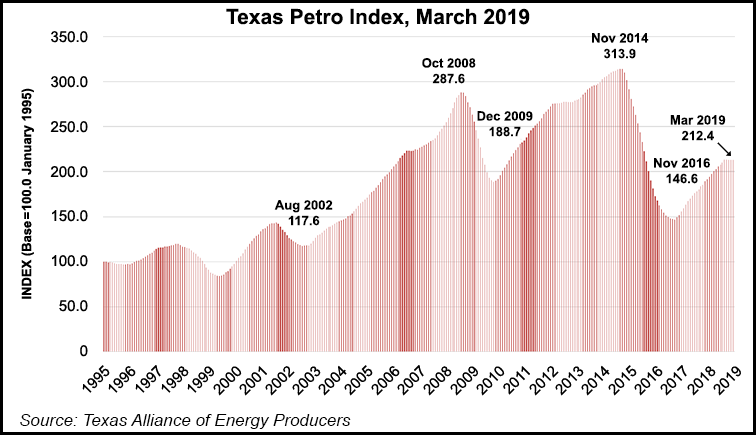Shale Daily | E&P | NGI All News Access | NGI The Weekly Gas Market Report
Texas Oil, Gas Industry Losing Jobs, Rigs but Production Still Gushing to Record Levels
Oil and natural gas activity in the Lone Star State remained flat through the first quarter, both year/year and sequentially, even as oil prices improve and production is at record levels and climbing, according to the Texas Petro Index (TPI).

The Texas Alliance of Energy Producers (TAEP), the largest independent statewide oil and gas association, compiles the monthly TPI on behalf of its 3,000 members.
The March index of 212.4 was down from February’s 213.1 and the December 2018 index of 212.9. The March index also was off more than 100 points (about 32%) below its November 2014 peak.
“In fact, the Texas Petro Index has generally been in a state of mild decline since its cyclical peak in October 2018,” TAEP noted. Still, “curious trends” are emerging, as “prices continue to improve and Texas crude oil production is still breaking records.”
The monthly measure of growth rates and cycles in the Texas exploration and production (E&P) indicators is based on the rig count, drilling permits, well completions and employment, which all remained in decline in March. The TPI is based at 100.0 in January 1995.
“Typically, these E&P indicators decline during an observable, sustained contraction in oil and gas activity, but that doesn’t appear to be what we’re seeing now,” said TAEP petroleum economist Karr Ingham, who created the TPI.
“I do think these decreases can partly — even largely — be attributed to the sharp and unexpected fourth quarter 2018 crude oil price declines, but clearly there are other forces at work. These have become increasingly evident over the course of the current recovery and expansion from the 2014-2016 industry downturn.”
These “forces” include ever-higher efficiencies achieved by Texas operators, according to the numbers.
“With crude oil production continuing to set milestones, the March monthly average rig count fell below 500, the fourth straight month of decline, compared to a monthly average of 904 in December 2014. The number of drilling permits issued in the first quarter is down by about 5% compared to year-ago levels and is off by nearly 40% compared to the 5,367 permits issued in the first quarter 2014.”
Direct upstream (E&P) industry employment is waning as well after reaching a cyclical peak in December.
Seasonally adjusted numbers compiled by the Federal Reserve Bank of Dallas, adjusted by the TAEP to strip out the few “mining” jobs in Texas that are not oil and gas related, suggest the loss of about 3,500 E&P jobs from December to March, TAEP noted.
In addition, the March estimate is down by more than 70,000 compared to the “all-time peak employment total in December 2014,” said officials.
“Industry employment and crude oil production estimates in March suggest that for every one direct upstream oil and gas employee, about 700 bbl of oil are produced, compared to about 170 bbl/employee in 2009,” TAEP said.
Oil production continued its upward ascent through the first quarter. However, production is exceeding 5 million b/d for the first time, based on TAEP estimates using data from the U.S. Energy Information Administration and the Railroad Commission of Texas.
“Given current price levels, which continue to improve, the Texas upstream oil and gas economy remains in expansion mode,” Ingham said. “But the nature of oil and gas economic growth in Texas is different in 2019 largely because it has become perfectly apparent that Texas oil and gas companies can produce more crude oil with fewer resources deployed.”
Oil pricing also is well below the June 2014 cyclical peak in crude oil prices of $100/bbl-plus, “and natural gas pricing in Texas is increasingly wretched in early 2019, thanks to continued deep discounts in Permian gas prices.”
© 2024 Natural Gas Intelligence. All rights reserved.
ISSN © 2577-9877 | ISSN © 1532-1266 | ISSN © 2158-8023 |
